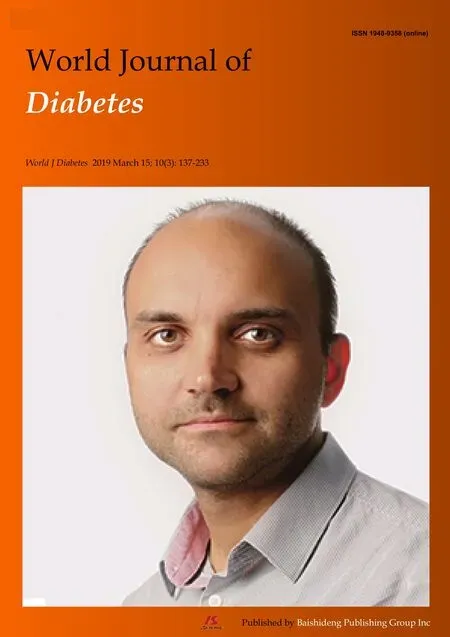Do we need to screen every patient in intensive care unit for diabetes in community with high prevalence of diabetes?
Taru Dutt,Rahul Kashyap,Salim Surani
Taru Dutt,Department of Neurology Research,Mayo Clinic,Rochester,MN 55902,United States
Rahul Kashyap,Department of Anesthesiology and Peri-operative Medicine,Critical Care IMP,Mayo Clinic,Rochester,MN 55902,United States
Salim Surani,Health Science Center,Texas A and M University,Corpus Christi,TX 78404,United States
Abstract
Key words:Diabetes mellitus;Intensive care unit;Microvascular;Macrovascular;Diabetes screening
INTRODUCTION
An estimated 30.3 million people of all ages,or 9.4% of the United States population had diabetes mellitus (DM) in 2015.This included 30.2 million adults aged 18 years or older (12.2% of all United States adults),of which 7.2 million (23.8%) were unaware of or did not report having DM.The percentage of adults with DM increased with age,reaching a high of 25.2% among those aged 65 years or older[1].In spite of the wide accessibility of knowledge about the early signs and symptoms of DM and ease of diagnostic modalities,many patients are oblivious of their disease[2].Worldwide approximately 193 million diabetic patients remain undiagnosed predisposing them to the development of several long-term complications of untreated chronic hyperglycaemia,making this a global health care challenge[3].
PREVALENCE OF DM IN AMONG CRITICALLY ILL PATIENTS
The complications of DM include both microvascular and macrovascular pathologies and comprise of retinopathy,neuropathy,renal failure,cardiovascular complications and increased risk of death.A study conducted by Tancrediet al[4]concluded that there is 15 fold increases on all-cause mortality in patients with Type-2 DM.These complications have profound physical as well as psychological burden on the patient,the family,and the care givers and on a larger scale they affect the health of the society.
On the other hand,intensive care unit (ICU) admissions with undiagnosed DM have been showing a steady increase in the past few years[2].Carpenteret al[2]studies the impact of undiagnosed DM in 9 ICU’s.The study reported that patients with undiagnosed DM had an increased mortality as compared to ICU patients with diagnosed DM;and also showed increased trend for higher average blood glucose level and insulin infusion.Thus need for DM screening amongst critically ill patients is paramount.
BENEFIT OF DM SCREENING
A study conducted by Kunthiet al[5]suggested that screening of subpopulations using risk scores can rule in high risk patients and the diagnosis can be confirmed by measurements of fasting plasma glucose or HbA1c concentrations or tests for oral glucose tolerance.Screening of the individuals who are at the risk of developing disease will prevent the long term microvascular as well as macrovascular complications.Early detection also helps in optimal disease management by practicing lifestyle modifications such as weight reduction,quitting smoking and alcohol,increased physical activity and healthy diet[6].However,various methods of screening may have used in the different studies including risk score,fasting plasma glucose,HbA1c concentrations or tests for oral glucose tolerance.This questions the applicability of a universal operational definition for DM diagnosis.
CONTROVERSIES AND COST EFFECTIVENESS OF DM SCREENING
Alongside,the various large multicentre studies concluded that macrovascular complications do not show any significant change[7].The risk of cardiovascular disease and other macrovascular complications does not improve with intensive management of the screened population;hence the application of universal screening method is not promoted[7].The UKPDS researchers[8]showed that despite an intense glycaemic and blood pressure control macrovascular outcomes were not improved but there was a significant improvement in retinopathy and albuminuria.Krinsleyet al[9]have shown that hyper-glycemia not only affects the morbidity in critically ill patients but also the patients admitted to the general medicine wards.They noted that high glucose variability (CV>20%) increased mortality in non DM patients in both ICU as well as the floor settings but for the DM patients it was restricted only for ICU.Patients with DM having low HbA1clevels and patients without DM have equal mortality and morbidity risks and hyperglycaemia increases mortality.Siegelaaret al[10],in their meta-analysis showed that the diabetic patients have higher chances of developing complications like sepsis or organ failure and these in turn have increased mortality rate compared to non-diabetic population.However,Diabetes does not serve as an independent factor for ICU mortality and after acquiring complications the morality rate would be same in diabetic as well as non-diabetic patients[10].
CONCLUSION
Despite DM being widely prevalent in United States,still substantial numbers of patients in older age are undiagnosed.This predisposes them to micro and macrovascular complications,which in turn may affect their morbidity and mortality during ICU stay.Universal screening of DM has been proved beneficial to prevent microvascular compilations but not much difference is seen in the macrovascular maladies.Early screening and management may be beneficial as controlled DM patients have similar morbidity as non DM patients in ICU.DM may be associated with increased mortality in ICU patients.However,how DM intrinsically affects the ICU mortality,is still open for discussion.
 World Journal of Diabetes2019年3期
World Journal of Diabetes2019年3期
- World Journal of Diabetes的其它文章
- Optimized health care for subjects with type 1 diabetes in a resource constraint society:A three-year followup study from Pakistan
- Burden of diabetic foot ulcer in Nigeria:Current evidence from the multicenter evaluation of diabetic foot ulcer in Nigeria
- Targeted genotyping for the prediction of celiac disease autoimmunity development in patients with type 1 diabetes and their family members
- Screening the RFX6-DNA binding domain for potential genetic variants in patients with type 2 diabetes
- Antidiabetic treatment on memory and spatial learning:From the pancreas to the neuron
- Crosstalk between gut microbiota and antidiabetic drug action
